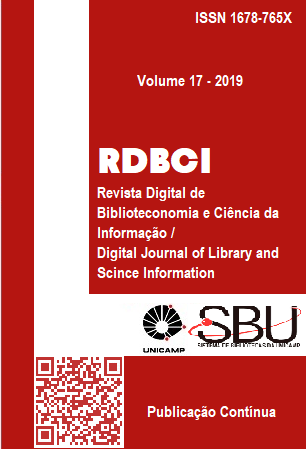Abstract
Creative cities are regions that concentrate people and places with a common goal: to make it a better place to live through different connections and using the best of each individual, creativity. Florianópolis, because it’s an island, where you can not install industries due to the limited space, stands out in the world of entrepreneurship and consolidates itself as a pole of technological innovation. The Sapiens Center (SC), when taking notice of international examples, sees in the eastern region of the center of Floripa, the opportunity for transforming the region. The perimeter has different types of institutions, among them information units. In this context, the goal is to map the information units that are located in the Creative District of Floripa and build the Route of Information Units. The justification is based on the premise that in order to build a creative environment it is necessary to contact information sources that link the past to the present, as well as to disseminate these spaces. For mapping and route creation, GMM was used. The route gathered 16 information units, the collections contain rare, historical, specialized, works, literature, among others; and 87.5% allow consultation of their collections.It is believed that the invitation to managers of the information units to integrate the group of partners of the SC will enable them to know the project and to feel included as agents of transformation of the site. In addition to meeting their colleagues and seeking the connection between the units for a common good.
References
BRADFORD, Neil. Creative cities structured policy dialogue backgrounder. Ottawa: Canadian Policy Research Networks, 2004. Disponível em: https://works.bepress.com/neil_bradford/53/download/. Acesso em: 16 jun. 2018.
CENTRO SAPIENS. Centro Sapiens. [201?]. Disponível em: https://centrosapiens.com.br/wp-content/uploads/2016/03/projeto-CentroSapiens.pdf. Acesso em: 10 jun. 2018.
CENTRO SAPIENS. Sobre o Centro Sapiens. 2018. Disponível em: https://centrosapiens.com.br/. Acesso em: 10 jun. 2018.
COMUNIAN, Roberta. Rethinking the creative city: the role of complexity, networks and interactions in the urban creative economy. Urban Studies, v. 48, n. 6, p. 1157–1179, 2011. Disponível em: http://journals.sagepub.com/doi/abs/10.1177/0042098010370626. Acesso em: 12 jul. 2018.
GARCÍA-REYES, Carmen Jorge. Gestión de unidades de información. In: VERGUEIRO, Waldomiro; MIRANDA, Angélica Conceição Dias (Org). Administração de unidades de informação. Rio Grande, RS: FURG, 2007.
GRODACH, Carl. Urban cultural policy and creative city making. Cities, v. 68, p. 82–91, 2017. Disponível em: http://dx.doi.org/10.1016/j.cities.2017.05.015. Acesso em: 4 jul. 2018.
GUINCHAT, Claire.; MENOU, Michel. Introdução geral as ciências e técnicas da informação e documentação. 2. ed. Brasília, DF: IBICT; FBB, 1994.
LANDRY, Charles. Prefácio. In: REIS, A. C.; KAGEYAMA, P. (Org.). Creative cities perspectives. São Paulo: Garimpo de Soluções, 2009.
NEWBIGIN, John. A economia criativa: um guia introdutório. [S.l.] :British Council. 2010. Disponível em: https://creativeconomy.britishcouncil.org/media/uploads/files/Intro_guide_-_Portuguese.pdf. Acesso em: 10 jun. 2018.
O’CONNOR, Justin.; SHAW, Kate. What next for the creative city? City, Culture and Society, v. 5, n. 3, p. 165–170, 2014. Disponível em: http://dx.doi.org/10.1016/j.ccs.2014.05.010. Acesso em: 10 jul. 2018.
PRODANOV, Cleber Cristiano; FREITAS, Ernani Cesar de. Metodologia do trabalho científico: métodos e técnicas da pesquisa e do trabalho acadêmico. Novo Hamburgo: Feevale, 2013.
PROGRAMA CIDADES SUSTENTÁVEIS. Bibliotecas em Bogotá. 2013. Disponível em: https://www.cidadessustentaveis.org.br/boas-praticas/bibliotecas-em-bogota. Acesso em: 7 dez. 2018.
RATIU, Dan Eugene. Creative cities and/or sustainable cities: discourses and practices. City, Culture and Society, v. 4, n. 3, p. 125–135, 2013. Disponível em: http://dx.doi.org/10.1016/j.ccs.2013.04.002. Acesso em 10 jul. 2018.
REIS, Ana Carla Fonseca. Cidades criativas: análise de um conceito em formação e da pertinência de sua aplicação à cidade de São Paulo. 2011 a. 297 f. Tese (Arquitetura e Urbanismo) - Faculdade de Arquitetura e Urbanismo, Universidade de São Paulo, São Paulo, 2011. Disponível em: http://www.teses.usp.br/teses/disponiveis/16/16139/tde-08042013-091615/pt-br.php. Acesso em: 14 jun. 2018.
REIS, Ana Carla Fonseca. Cidades criativas: burlando um conceito em formação. Revista de Moda, Cultura e Arte: São Paulo, v. 4, n. 1. p.127-149, 2011b. Disponível em: http://www1.sp.senac.br/hotsites/blogs/revistaiara/wp-content/uploads/2015/01/12_IARA_vol4_n1_Reflexoes.pdf. Acesso em: 4 jul. 2018.
ROMANI, Claudia.; BORSZCZ, Iraci. Unidades de informação: conceitos e competências. Florianópolis: UFSC, 2006.
SCOTT, Allen. Creative cities: conceptual issues and policy questions. Journal of Urban Affairs, v. 28, n. 1, p. 1–17, 2006. Disponível em: http://onlinelibrary.wiley.com/doi/10.1111/j.0735-2166.2006.00256.x/abstract. Acesso em 10 jul. 2018.
VERGUEIRO, Waldomiro; MIRANDA, Angélica (Org). Administração de unidades de informação. Rio Grande, RS: FURG, 2007.
VIA. Conexões. 2018. Disponível em:http://via.ufsc.br/conexoes/. Acesso em: 16 dez. 2018.

RDBCI: Revista Digital de Biblitoeconomia e Ciência da Informação / Digital Journal of Library and Information Science uses the Creative Commons (CC) license, thus preserving the integrity of articles in an open access environment, in which:
- This publication reserves the right to modify the original, regarding norms, spelling and grammar, in order to maintain the standards of the language, still respecting author writing style;
- The original documents will not be returned to the authors;
- Published works become Revista Digital de Biblitoeconomia e Ciência da Informação / Digital Journal of Library and Information Science's property, their second partial or full print being subject to expressed authorization by RDBCI's editor;
- The original source of publicaton must be provided at all times;
- The authors are solely responsible fo the views expressed within the document.






